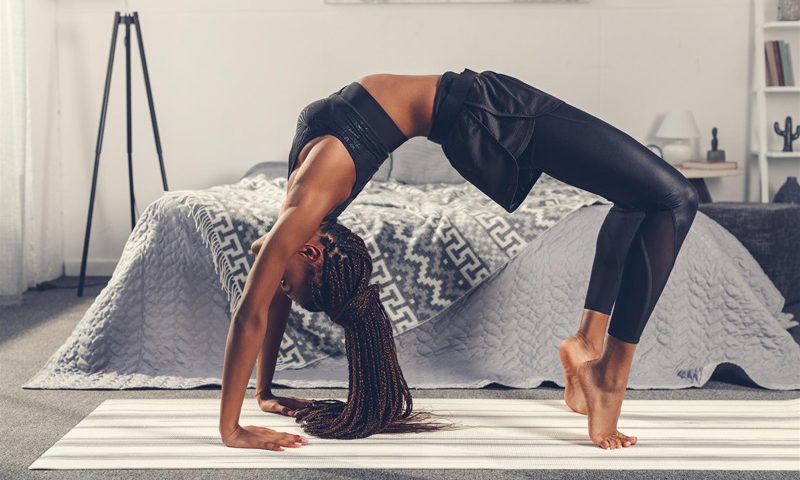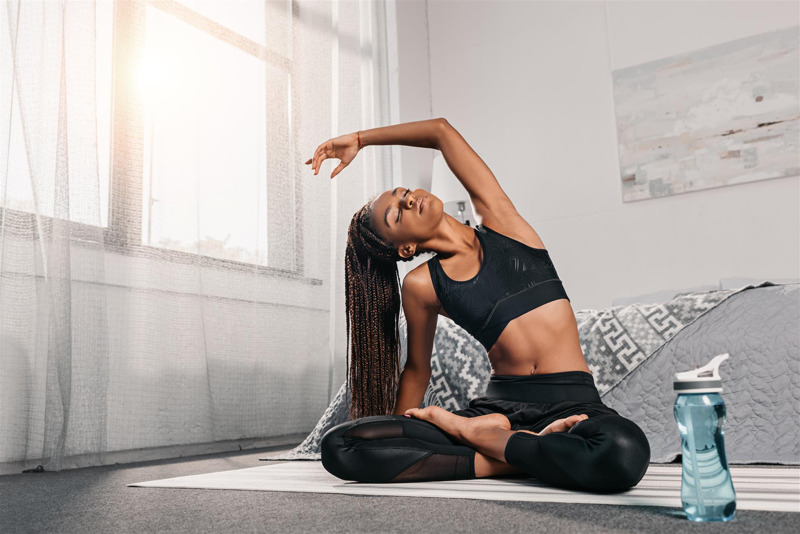
5 Myths About Meditation
August 23, 2018
Why is it Important to Listen to Your Body?
September 11, 2018Calming Yoga Sequences

In addition to a range of physical benefits, yoga boasts a number of mental benefits, too. Out of these, one of the most popular is relaxation. Ideal for those looking to wind down after a busy day, yoga can be used to calm the body and mind before heading off to bed. For best results, it’s important to wear comfortable clothing whilst you practice. During the warmer months, a light-weight yoga top and a pair of leggings are ideal. In this article, we look into a calming yoga sequence.
Supported Child’s Pose
The first posture in the sequence is Supported Child’s Pose. Regarded as one of the best ways to balance the nervous system, this posture is ideal for those looking to calm the mind. For best results, practice the restorative posture with your eyes closed and the lights turned down. Before you begin, make sure you have a pillow or blanket to hand as you will need this to perform the pose. If possible, choose a prop that is long enough to support the entire front of your body; if you can’t find anything that’s suitable, consider using two pillows instead of one.
To practice the pose, kneel on your mat with the pillow placed in front of you. Next, take a deep breath in and sit back on your heels, lengthening your spine as you do so. As you breathe out, slowly walk your hands out in front of you until your torso is resting on the pillow. Finally, place your forehead against the pillow and rest your arms by your sides. You are in Supported Child’s Pose. Hold the asana for around 5 minutes whilst breathing deeply.
Happy Baby Pose
A popular restorative pose, Happy Baby is worth including in the sequence. As well as relaxing the mind, this posture can be used to combat a headache. Typically, a headache stems from tension in the back. If caught early enough, Happy Baby Pose can be used to prevent discomfort from radiating up the spine.
To practice the asana, lie flat on your back with your knees bent. Next, grab your feet and begin to rock slowly from side to side. The more you rock, the deeper the stretch. You are in Happy Baby Pose. Perform the exercise for around 1 minute before resting your feet on the mat.
Waterfall Pose
The next posture in the routine is Waterfall Pose. A softer variation of the popular pose ‘Shoulder Stand’, Waterfall Pose is a great alternative if you’re looking to calm the mind. Better still, as the posture doesn’t invert your uterus it is safe for women to practice during their menstrual cycle. If you’re new to this pose, consider practicing against a wall at first.
To practice the asana, lie flat on your back on your mat. Next, bend your knees and press your feet firmly into the mat as if you are getting ready for Bridge Pose. When you’re ready, begin to lift your hips up and place a block under your lower back. One at a time, bring your knees into your chest before lengthening them straight up. If you’re practicing the pose against a wall, both your legs should now be resting against it. You are in Waterfall Pose. Hold the asana for around 30 seconds before lowering your legs back down to the mat.

Legs Up The Wall
Another popular pose, Legs Up The Wall Pose relaxes the mind whilst also improving blood circulation. To practice the asana, place the shortest end of your yoga mat against a wall. When you’re ready, take a seat on the mat facing the wall. Next, lie back on the mat and extend your legs up the wall. For best results, your bottom should be touching the wall and your legs should remain closed. You can rest your hands wherever feels most comfortable; many yogis choose to rest them on their stomach or on the mat. You are in Legs Up The Wall Pose. Hold the posture for around 5 minutes or for however long feels comfortable.
Supported Half Frog Pose
In addition to relaxing the mind, Supported Half Frog opens the hips, inner thighs, and pelvic floor to release tension. For best results, consider using a pillow or blanket during the posture. To practice the asana, lie flat on your stomach with your pillow placed on the right-hand side of your body. Most people find that the best position for the pillow is in-line with your hips. Next, stack your hands-on top of one another and rest your head on the back of them. Bending your right knee at 90 degrees, bring your right leg out in line with your hip. The inside of your right thigh should now be resting on your pillow. You are in Supported Half Frog Pose. Hold the posture for around 30 seconds before repeating on the opposite side.
Corpse Pose
Another great restorative pose, Corpse Pose is the perfect way to end the sequence. Encouraging the body and mind to completely relax, the posture is great to practice before heading off to bed. Better still, the pose is super simple to practice! All you need to do is lie down on your back with your legs stretched out, and relax your arms by your sides. You are in Corpse Pose. Take this time to close your eyes and reflect on the session. If you’re struggling to relax, try to focus on your breathing until you feel the stress seep away.
In Summary
Whether you’re hoping to relax before heading to work or you’re more interested in winding down before bed, practice the asanas above to calm the mind. While some yogis prefer to attend a yoga class, others are happy to practice independently. During the summer months, many yogis enjoy practicing in their garden or local park. If you decide to do this, make sure to wear a good-quality SPF and a yoga cap to protect your skin from the UV rays.

